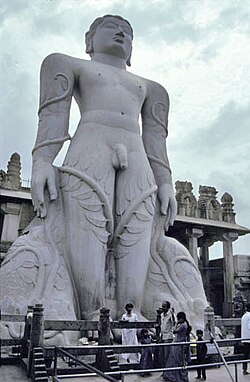Digambara
Digambar (sky-clad in Sanskrit) (alternate orthographies: Digambara), has many different meaning and associations throughout Indian religions. Many representations of deities within these traditions are depicted as sky-clad. Certain traditions and lineages also practice Digambar as a lifelong vow as evidenced by numerous sadhu throughout India.
Iconography
In the iconography of the Indian religions, Digambar may be understood as enveloped by the quintessential investiture of akasha, space or ether.
Jainism
Digambara is one of the two main sects of Jainism, the other being Svetambar.

The modern Jainism is generally divided into two traditions, Digambar and Svetambar. Generally Digambar monks wear no clothes (dig ambar = sky clad), Svetambar (swet ambar = white clad) monks usually wear white clothes.
Until the leadership of Acharya Bhadrabahu, there was no significant division. After that some divisions gradually arose. Senior Digambar monks wear no clothes, following the practice of Lord Mahavira. They do not consider themselves to be nude -- they are wearing the environment or stated differently the quintessential, akasha or space. Digambaras believe that this practice represents a refusal to give in to the body's demands for comfort and private property -- only Digambara ascetics are required to forsake clothing. Digambara ascetics have only two possessions: a peacock feather broom and a water gourd. Svetambara monks usually wear white clothes, maintaining that nudity is no longer practicable. While there are some differences in some practices, the main principles like Mahavratas, Anuvratas etc. are the same.
Digambara Jain Communities in India
The native Jain communities of Maharashta, Bundelkhand (MP/UP), Karnataka, Tamil Nadu are all Digambaras. In north India, the Saravagis and the Agrawals are also Digambaras. In Gujarat and Southern Rajasthan, the majority of Jains follow the Svetambara tradition, although some Jain communities of these regions like the Humad are also Digambaras.
Digambara also has different communities under it such as Saitwal, Lad, Khandelwal, Bagherwal, Aggarwal etc. Saitwal is a well-known and well-organized caste of Marathi-speaking Jain communities. They are high in number. Saitwals are spread all over Maharashtra, South Madhya Pradesh and North Karnatak.
The traditional occupation of Saitwals is tailoring. This is a well-educated community and it has given many writers and scholars to the Jain community. They are progressive and social-minded. Most of their surnames are based on their original villages.
Parwars mainly come from Bundelkhand (MP/UP). They are one of the most learned amongst Jains. Most Pandits and Pujaris of tirthakshetras are Parwars.
Digambara Monastic Tradition
The prominent Acharyas of the Digambar tradition were:
- Acharya Kundakunda: author of Samayasar, etc.
- Acharya Virasena: author of Dhavala
- Acharya Aryanandi (monk).
In around 10th century Digambar tradition was divided into two main orders.
- Mula Sangh: includes Sena gana, Deshiya gana, Balatkara gana etc.
- Kashtha Sangh: includes Mathur gana, Lat-vagad gana, etc.
Acharya Shantisagar, the first Acharya of the 20th century, belonged to the tradition of Sena gana. Practically all the Digambara monks today, belong to the tradition of Acharya Shantisagar directly or indirectly.
The Bhattarakas of Shravanabelagola and Mudbidri belong to Deshiya gana and Bhatttara of Humbaj belongs to Balatkara gana.
Among the prominent Digambara Acharyas today are Acharya Vidyasagar, Acharya Vidyanand and Acharya Pushpadant.
Sub-sects of Digambara Tradition
Those following the Terapanth reforms are called Terapanth and others following more traditional practices are called Bisapanthai. In practice, the Bisapantha / Terapanth division is not important, and separate institutions do not exist.
Among the Digambaras, the Taran Panthi follow Taran Swami and Kanji Panthi follow Kanji Swami.
See also
References
- Fisher, Mary Pat (2003). Living Religions (5th Edition).
